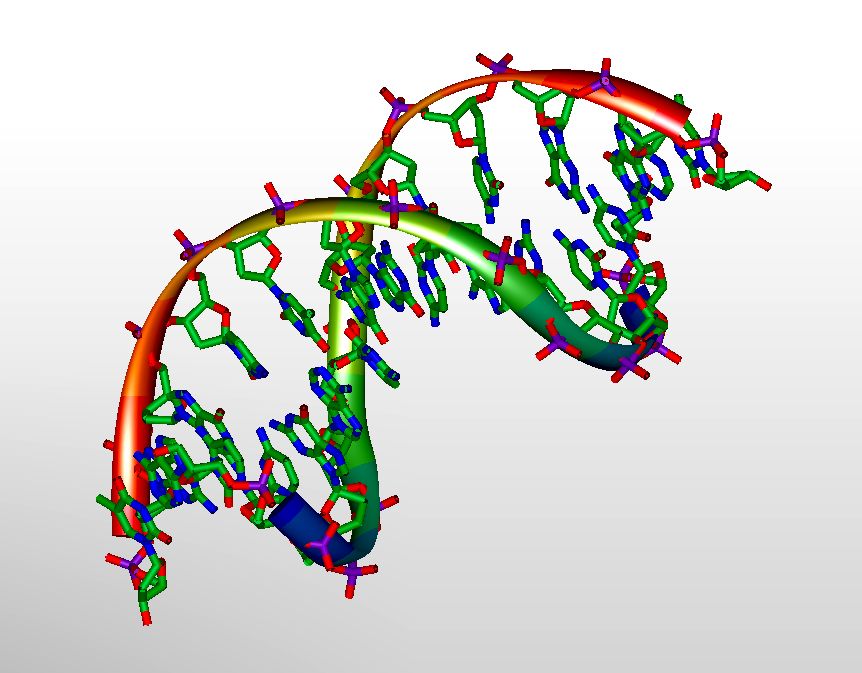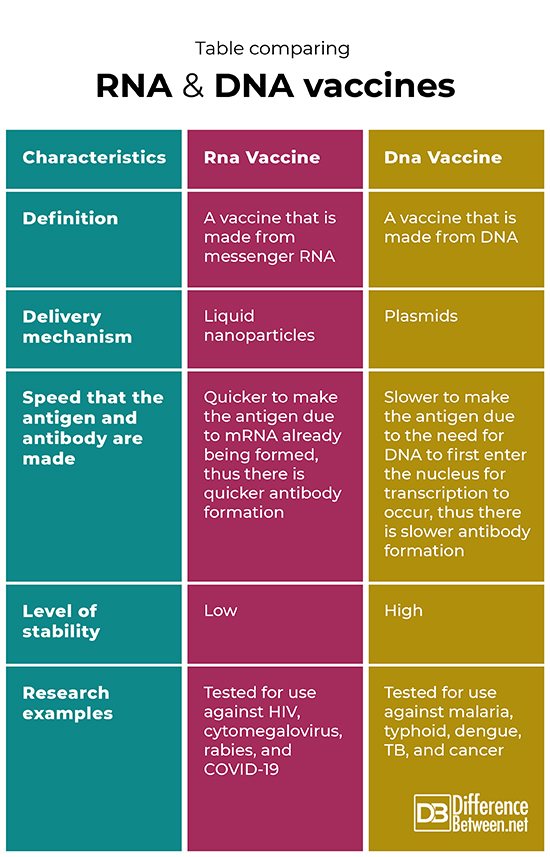Difference Between RNA and DNA vaccines
An RNA vaccine is when a vaccine is made up of messenger RNA that will cause the body’s immune system to respond to a particular virus. A DNA vaccine is when a vaccine consists of the DNA of a pathogen that will trigger an immune response.

What is RNA vaccine?
Definition:
An RNA vaccine is made from a part of messenger RNA that can induce the production of an antibody in the person receiving the vaccine.
Production of the vaccine:
RNA vaccines are derived from the mRNA of viruses, via a process of genetic engineering. The RNA vaccine is carried in the form of a liquid nanoparticle that consists of lipids. The potential for such vaccines is great and, therefore, much research is being conducted on the development of RNA vaccines to combat COVID-19. The discovery of mRNA-1273 of the coronavirus is promising for the subsequent development of an RNA vaccine to stimulate antibody production.
How it works:
The idea behind an RNA vaccine is to trigger an immune response in which T lymphocytes are activated and a response is mounted against the particular viral disease. The mRNA sequence is that which codes for an antigen of the illness; an antigen is a protein that the immune system will then recognize as foreign. Antibodies will then be manufactured by the body in response to this antigen.
Advantages:
The genetic code is already in a transcribed form for protein synthesis in the case of these vaccines. RNA vaccines are also believed by many scientists to be less risky than DNA vaccines since they would not affect the host’s DNA or even have to enter the nucleus of a host cell because the mRNA has already been formed. This also means the process of making antibodies is faster.
Disadvantages:
The technology is fairly new and relies on nanotechnology, and so far none of these have been approved by the FDA for use in people. A further disadvantage is that since only a part of the viral mRNA can be used, the immune response that is activated may not be very strong. This would mean a person would need to get boosters every so often to maintain a high level of immunity. RNA degradation is a concern and thus more engineering is needed with substances added to protect the RNA and allow storage.
Research examples:
No RNA vaccines have been approved for use in humans as of yet, but research is ongoing on the use of RNA vaccination against HIV, cytomegalovirus, rabies, and also COVID-19. There are already clinical trials testing the effectiveness and safety of COVID-19 vaccines based on messenger RNA.

What is DNA vaccine?
Definition:
A DNA vaccine uses a genetically altered plasmid which contains a piece of DNA from a virus in order to activate an immune response.
Production of the vaccine:
The vaccine is made using DNA from a virus, which codes for an antigen. The antigen then elicits the formation of antibodies by the person’s body, which helps in the event of exposure to the virus that the particular DNA vaccine is designed for.
How it works:
A plasmid is used and modified to carry DNA of a virus. The plasmid is circular DNA from a prokaryotic bacterial cell, which is used in genetic engineering in molecular biology. The plasmid is inserted into the person when they are vaccinated.
Advantages:
Scientists have more knowledge and experience working with plasmids, so the process is somewhat easier compared with the nanotechnology involved in RNA vaccines. DNA is also less susceptible to degradation and more stable in a lab setting compared with RNA. This makes it easier and requires fewer steps for extraction and storage of the DNA compared with RNA.
Disadvantages:
Unlike an RNA vaccine, with which it may be confused, a DNA vaccine only contains DNA. This means an extra step is needed for making the antigen since mRNA has to first be transcribed in the nucleus from the DNA. This means it would take longer for the antibody response to be triggered.
Research examples:
DNA vaccines have been investigated for use to treat the following illnesses: malaria, typhoid, dengue, TB, and cancer. At the current time, DNA vaccines have not been approved for use in humans, although some have been approved for use in animals.
Difference between RNA and DNA vaccines?
Definition
An RNA vaccine is a type of vaccine that is made from messenger RNA. A DNA vaccine is a vaccine made from DNA.
Delivery mechanism
The delivery mechanism of an RNA vaccine is via liquid nanoparticles. The delivery mechanism of a DNA vaccine is by use of a plasmid.
Speed that the antigen and antibody are made
In the case of an RNA vaccine, an antigen is made quickly, and therefore, the body rapidly forms antibodies. For a DNA vaccine, an antigen is made more slowly, which means that antibody production is slow.
Level of stability
An RNA vaccine is unstable and more prone to degradation in the lab. A DNA vaccine is stable and does not break down easily.
Research examples
Research has been done on the use of RNA vaccines for treating HIV, cytomegalovirus, rabies, and COVID-19. Research has been done on the use of DNA vaccines for treating malaria, typhoid, dengue, TB, and cancer.
Table comparing RNA and DNA vaccines

Summary of RNA Vs. DNA vaccines
- Both RNA and DNA vaccines are based on nucleic acids and are used to trigger both a cell-mediated and humoral immune response.
- RNA vaccines are being developed to use against illnesses such as HIV and COVID-19.
- DNA vaccines are more stable than RNA, but tend to work slower.
- Difference Between Rumination and Regurgitation - June 13, 2024
- Difference Between Pyelectasis and Hydronephrosis - June 4, 2024
- Difference Between Cellulitis and Erysipelas - June 1, 2024
Search DifferenceBetween.net :
Leave a Response
References :
[0]Fuller, Deborah H., and Peter Berglund. "Amplifying RNA vaccine development." New England Journal of Medicine 382.25 (2020): 2469-2471.
[1]Garde, D. "An updated guide to the coronavirus drugs and vaccines in development." Stat News, 19.03 (2020).
[2]Khan, Kishwar Hayat. "DNA vaccines: roles against diseases." Germs 3.1 (2013): 26.
[3]Image credit: https://upload.wikimedia.org/wikipedia/commons/thumb/3/37/Difference_DNA_RNA-EN.svg/500px-Difference_DNA_RNA-EN.svg.png
[4]Image credit: https://en.wikipedia.org/wiki/File:DNA_3D_Model.png
